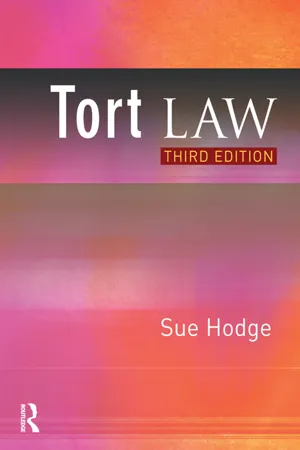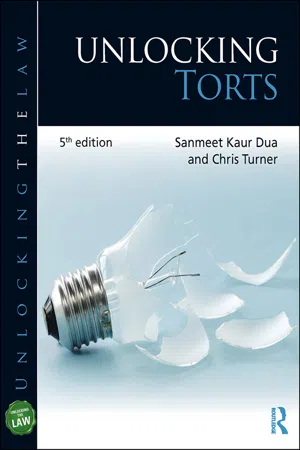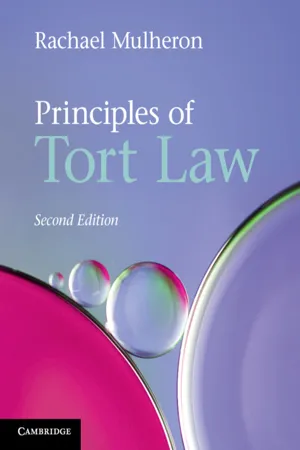Law
Assault
Assault refers to the intentional act of causing someone to fear that they will be physically harmed. It does not necessarily involve physical contact, but rather the threat or attempt to cause harm. In legal terms, assault is often distinguished from battery, which involves actual physical contact.
Written by Perlego with AI-assistance
Related key terms
1 of 5
8 Key excerpts on "Assault"
- eBook - ePub
Violence in American Society
An Encyclopedia of Trends, Problems, and Perspectives [2 volumes]
- Chris Richardson(Author)
- 2020(Publication Date)
- ABC-CLIO(Publisher)
Although it lacks a universal legal definition, contemporary American understandings of Assault can be traced back to British common law (a law based on judicial precedent rather than statutes), in which it is described as “an attempt, with violence, to do corporal injury to another … As by striking … or any other act done in an angry manner” (Hawkins and Leach 1788, 621). In the event the attempt at injury is successful, the offending individual has committed battery, which was defined in common law as “any injury actually done to the person of another; as spitting in his face; treading on his shoes; [or] jostling him in a revengeful manner” (ibid.). In simple terms, Assault can be generally understood as a threat or attempt to cause physical harm to another person, regardless of whether that attempt is successful, whereas battery is the act of causing harm. In this definition, every act of battery will necessarily include Assault, but not every Assault will include battery. For instance, if one convincingly threatens to cause physical harm to another but does not follow through with the threat, one has only committed Assault.The common law definition has served as the foundation for the nation’s legal and cultural understandings of Assault and battery, from the colonial period (1607–1775) to the present day. Yet for an act so pervasive and ostensibly simple, Assault and battery can quickly become very complicated depending on, among other things, the state in which it is committed, the status or age of the victim and perpetrator, and the relationships between the parties. For example, in Title 8, Chapter 9 of the 2016 California Penal Code, Assault is defined as “an unlawful attempt, coupled with the present ability, to commit a violent injury on the person of another” (§ 240). Battery, meanwhile, is defined as “any willful and unlawful use of force or violence upon the person of another” (§ 242). Like the early common law definition, California Penal Code defines Assault and battery as separate but related acts. New York Penal Law, on the other hand, indicates that a person is guilty of Assault “when, with intent to cause physical injury to another person, he or she causes such injury to that person [or to a third person]” (§ 120.00–1). In New York, as in many other states, the previously separate acts of Assault and battery have been combined into a single act.With a small number of exceptions, Assault is generally prosecuted under state law, which is specific to the society it is designed to govern. For that reason, the ways in which Assault is understood and prosecuted will change based on the context in which it is applied. In order to understand the various ways in which Assault is interpreted, perpetrated, and punished in contemporary American society, one must go back to the colonial period and trace its evolution from vague common law to an indispensable element of state and federal law. - eBook - PDF
Criminal Law in Cameroon
Specific Offences
- Carlson Anyangwe(Author)
- 2011(Publication Date)
- Langaa RPCIG(Publisher)
But even the bravest, strongest and most cunning of men may become particularly weak and thus very vulnerable as when, for example, he is asleep, drunk, taken by surprise, sick, outclassed or outnumbered. The criminal law admonition, ‘thou shall not kill’ or ‘thou shall not harm’ thus aims at protecting the weak, which means practically every person, against injury by another person. The law punishes not only the unlawful taking away of human life; it also punishes other forms of violence not resulting in death. In a general way it can be said that the law punishes Assaults and threats against the person. In popular language Assault connotes a physical attack or aggression such as striking, stabbing, pushing, or inflicting any hurt whatever on another. In fact, however, the term includes certain types of unlawful interference with another; hence expressions such as ‘indecent Assault’, ‘sexual Assault’, and ‘non-sexual Assault’. Historical . In some jurisdictions ‘Assault’ is used as a generic expression to describe what in Anglo-American law is technically known either as ‘Assault’ (that is, the threat by a person to inflict any unlawful force whatever, light or heavy, upon another raising an apprehension in the mind of the victim) or battery (that is, the actual application of any unlawful force whatsoever, be it ever so small, to another without his consent). That distinction between psychic and physical Assault already existed in the common law of England as far back as during the Middle Age. The Roman law injuria (legal wrong) was much wider in scope. It included conduct nowadays punishable as Assault. An injuria committed against another’s dignity was punishable as crimen injuria, and, against another’s reputation, as criminal defamation. Causing someone to fear physical violence was punishable as injuria realis , while actual physical violence against another’s bodily integrity was punishable as injuria corpus. - The Shorter Oxford Dictionary defines Assault as ‘an onset with hostile intent; an attack with blows or weapons’. In the criminal law the word ‘Assault’ is used as a general term to cover various crimes against the person. In the law of tort, however, the word has a specific meaning which can be summarised as a threat that force will be used against the victim. A more formal definition is ‘some conduct by the defendant which causes the victim reasonably to fear that force is about to be used upon their person’.Figure 1.1 Threatening conductIn many cases the conduct is obviously threatening, for example shaking one’s fist in someone’s face will usually cause that person to fear that a punch is about to be thrown at them. Other factors may be relevant and in some cases have the effect of preventing the action from amounting to an Assault.The physical action may be accompanied by words. These can have the effect of enhancing the threat; for example, ‘I’ll get you for that’ may well make the threat more credible. On the other hand, words can have the effect of negating the threat by making it clear that the threatened use of force will not occur.Tuberville v Savage (1669)In this case there was an Assault when the perpetrator put his hand on his sword and said, ‘T’were not assize time, I’d not take such language from you’. The victim alleged that he had been in fear that he was about to be attacked with the sword. It was decided that the words used meant that had the judges not been in town on assize, this would indeed have occurred but that as the judges were there, nothing further would happen. There was no Assault.Opinion has been divided as to whether or not words alone can amount to an Assault. One old case, Meade’s Case (1823), held that words alone cannot be an Assault; more recently, in 1955, a criminal case, R v Wilson, held that they could. The position now appears to be that certainly in relation to criminal law, and therefore almost certainly in relation to the law of tort, threatening words alone can be enough. In R v Ireland
- eBook - ePub
- Sanmeet Kaur Dua, Chris Turner(Authors)
- 2019(Publication Date)
- Routledge(Publisher)
Trespass to the person has three components which may occur together or separately. Each of itself gives rise to a cause of action. The components are:Assault and battery will each be defined and explained, the defences applicable to both these torts being considered together. False imprisonment will then be considered separately.■ Assault■ battery■ false imprisonment.Trespass to the person can be committed in one of three ways (see Figure 13.1 ).13.2 Assault
13.2.1 Definition
The tort can be defined in various ways. For example:■ ‘The act of putting another person in reasonable fear or apprehension of an immediate battery by means of an act amounting to an attempt or threat to commit a battery amounts to an actionable Assault’ (R E V Heuston and R A Buckley, Salmond and Heuston on the Law of Torts (20th edn, Sweet & Maxwell, 1992), p. 127).■ ‘Assault is an act of the defendant which causes the claimant reasonable apprehension of the infliction of a battery on him by the defendant’ (W V H Rogers, Winfield and Jolowicz on Tort (16th edn, Sweet & Maxwell, 2002), p. 71).■ ‘An Assault is an act which causes another person to apprehend the infliction of immediate, unlawful, force on his person’ (Goff LJ in Collins v Wilcock [1984] 3 All ER 374).Figure 13.1 How liability is established in the different types of trespass to the person.As will be seen, none of these definitions covers all the essential elements of the tort. A better definition is perhaps: an Assault is some direct and intentional conduct by the defendant which causes the victim reasonably to fear that unlawful force is about to be used upon their person.13.2.2 Ingredients of the tort
Direct and intentional
The words direct and intentional have the meaning discussed in section 13.1 .Conduct
Conduct in this context amounts to something which threatens the use of unlawful force. An obvious example is shaking a fist under someone’s nose causing them to fear that they are about to be punched. In most cases it may be true that the assailant’s actions clearly convey the necessary threat, but this is not always so. - eBook - ePub
- Rodger Geary(Author)
- 2012(Publication Date)
- Routledge-Cavendish(Publisher)
Chapter 5Offences Against the PersonNon-Fatal OffencesAssaultIt is now settled by s 39 of the Criminal Justice Act 1988 that Assault and battery are two separate offences (DPP v Little (1991)). However, the term ‘common Assault’ has been held to mean either Assault or battery (Lynsey (1995)).Actus ReusIn R v Burstow, R v Ireland (1997), the House of Lords confirmed the traditionally accepted definition of Assault:Any act by which a person intentionally or recklessly causes another to apprehend immediate and unlawful personal violence.Their Lordships also cleared up an area of long term uncertainty in the criminal law, by holding that an Assault could be committed by words alone. Indeed, Lord Hope indicated that an Assault would be committed in the context of a silent telephone call where the silence conveys a threatening message to the victim. It should be noted that this is not an Assault by omission since there clearly is an act: that of making the phone call. It seems that the courts will now consider whether, as a result of the defendant’s actions (including his words and silences), the victim feared immediate physical violence. If so, then it would appear that the actus reus of Assault has been established.Not only can words constitute an Assault, but they can also negate an Assault. In the old case of Tuberville v Savage (1669), there was held to be no Assault when the defendant reached for his sword and said: ‘If it were not assize time I would not take such language from you.’ Since, in fact, the judges were in town, the meaning of this statement was that the defendant was not going to attack the victim. The fear that might have been caused by the conduct of reaching for the sword was negated by the accompanying words. However, it is suggested that the words must amount to an unconditional - eBook - PDF
- Rachael Mulheron(Author)
- 2020(Publication Date)
- Cambridge University Press(Publisher)
See also earlier, at trial, [2005] EWHC 2034 (QB) [35], citing: R v Ireland [1998] AC 147 (HL) 161–63 (Lord Steyn). 696 Trespass to the Person commit a battery, coupled with the capacity to carry that intention into effect, causing another to apprehend the infliction of immediate and unlawful force’. The tort is actionable per se . Hence, the tort embodies three elements. Element #1: An Overt Act, and Intention §14.9 For the tort of Assault, D must commit an overt act, with an intention to inflict force immedi-ately or imminently upon C. That intention may be wilful or reckless. An intention to inflict future force is not sufficient. An ‘overt’ act means a word or deed which is openly done by D. Something said or done can be sufficient to cause an apprehension of immediate personal violence. In Hepburn v CC of Thames Valley Police , 46 the following example was given: D does not Assault C by merely passively standing in front of C, getting in their way, and refusing to move; it is an Assault to take active measures to block or obstruct C from moving in a particular direction with some threat of physi-cal interference if he does so. In R v Ireland , 47 Lord Steyn gave the example of a man accosting a woman in a dark alley, saying, ‘Come with me or I will stab you’, which can constitute an Assault by words. D must intend to inflict immediate force on C. An intention to inflict force or violence in the future is not sufficient; C must apprehend immediate force or violence. In Mbasogo v Logo Ltd , 48 a coup was allegedly organised against the president of the African State of Equatorial Guinea (a country rich in oil and gas) by a group of special forces soldiers who had served in South Africa and mercenaries. An advance group of twenty special forces soldiers was to gain intelli-gence and prepare and participate in the attack. - eBook - PDF
- Joel Samaha(Author)
- 2016(Publication Date)
- Cengage Learning EMEA(Publisher)
Threatened battery Assault, sometimes called the crime of “intentional scaring,” requires only that actors intend to frighten their victims, thus expanding Assault beyond attempted bat- tery. Threatened battery doesn’t require actually having the intent to injure their vic- tims physically; the intent to frighten victims into believing the actor will hurt them is enough. (See the Elements of Assault Box.) attempted battery Assault having the specific intent to com- mit battery and taking substantial steps toward carrying it out without actually completing the battery threatened battery Assault intentional scaring requiring only that actors intend to frighten their victims, thus expanding Assault beyond attempted battery ELEMENTS OF Assault Actus Reus (Voluntary Act) 1. Attempted Assault Substantial steps toward completing a battery or 2. Threatened battery Voluntary acts that frighten victims Mens Rea 1. Attempted Assault Intent to commit battery or 2. Threatened battery Intent to frighten victim Circumstance If any required by statute Causation Factual and legal cause Criminal Harm Defendant’s acts cause fear in the victim (threatened battery) Copyright 2017 Cengage Learning. All Rights Reserved. May not be copied, scanned, or duplicated, in whole or in part. Due to electronic rights, some third party content may be suppressed from the eBook and/or eChapter(s). Editorial review has deemed that any suppressed content does not materially affect the overall learning experience. Cengage Learning reserves the right to remove additional content at any time if subsequent rights restrictions require it. 409 BODILY INJURY AND THREATS OF BODILY INJURY CRIMES Victims’ awareness is critical to proving threatened battery Assault. Specifically, victims’ fear of an immediate battery has to be reasonable. Words alone aren’t Assaults; threatening gestures have to accompany them. - James Walsh(Author)
- 2002(Publication Date)
- Auerbach Publications(Publisher)
The basic elements of crimes of force against a person are: • The use of force or threat of force • The actual injury or intimidation of the victim As with any crime, the accused must be shown to have acted knowingly and with the intent to do the specific act prohibited. This intent may be presumed in crimes of negligence but must be proven specifically in the other crimes. This means that any defense tending to rebut the criminal intent by showing another purpose, such as protecting or repossessing one’s own property or by showing justification for the intentional use (such as defense of self or another, assisting a police officer at his com-mand, etc.) is relevant. As every crime must be proven beyond a reasonable doubt, credible evidence of such noncriminal purpose or intent may be enough to secure an acquittal. Inherent to crimes of force or threatened force is the concept of justifica-tion — for example, the use of force for some purpose approved by the law. For security professionals, this often is a crucial issue, because circum-stances may arise where it is possible to use force against individuals. What kind and how much force gets determined on a case-by-case basis, so it is essential to have a general awareness of lawful limits on the use of force.
Index pages curate the most relevant extracts from our library of academic textbooks. They’ve been created using an in-house natural language model (NLM), each adding context and meaning to key research topics.







